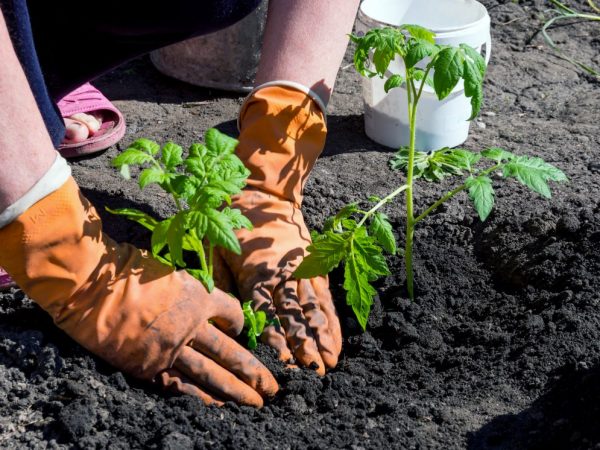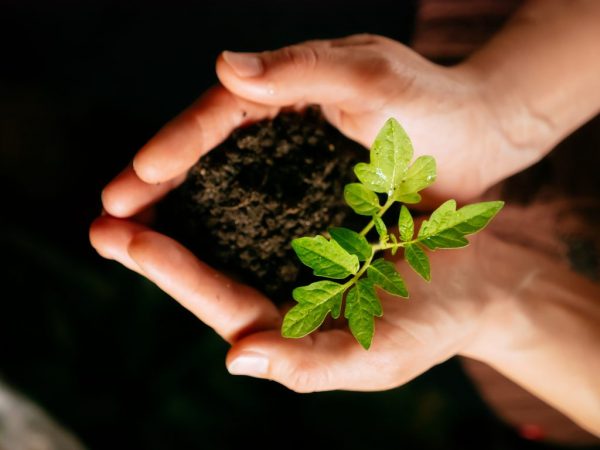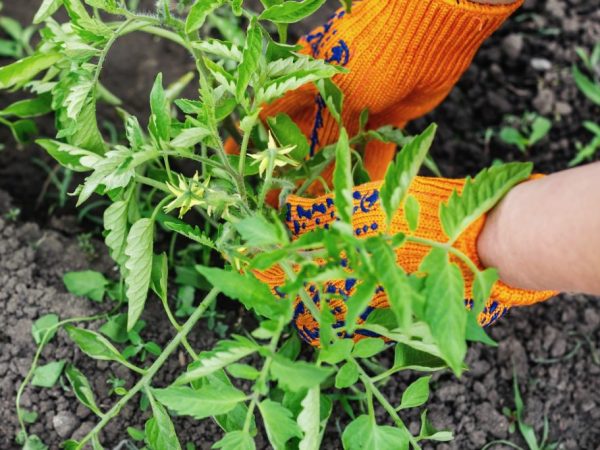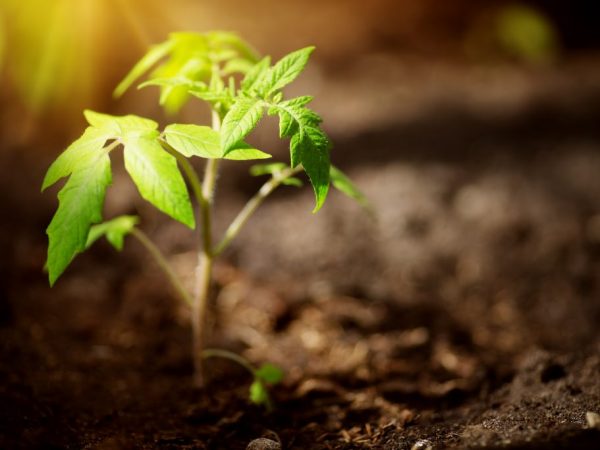Rules for planting tomato seedlings in open ground
In the process of cultivation of tomatoes, the growth and development of the plant is significantly influenced by the climate and compliance with the planting rules. We will tell you when tomato seedlings should be planted in open ground.

Rules for planting tomato seedlings in open ground
Preparatory activities
The success of the future harvest directly depends on the correct planting of tomatoes in open ground. Among the main preparatory measures for planting tomatoes, soil preparation takes a special place. They begin to cook tomatoes for open ground long before planting procedures, in the fall.
Seat selection
For planting tomatoes in open ground in a personal plot, choose a place illuminated by the sun and not in the shade.
When choosing a garden bed, it is important to adhere to the principles of crop rotation: do not plant tomatoes in the same place for several years in a row. This will protect the tomato seedlings from late blight.
Potatoes will also become a bad predecessor for tomatoes: they are able to accumulate and transmit plant diseases through the ground. The predecessors, after which tomatoes are planted in open soil, are beets, carrots, corn and beans.
Fertilizers
It is recommended to fertilize the soil before winter, adding rotted manure fertilizer or humus in the process of digging the soil at the rate of 1 bucket per 1 sq. m of sown area. With an insufficient amount of fertilizer, it can be applied locally 7 days before planting seedlings directly into the holes, adding a handful of ash powder or humus with your own hands.
Disinfection
Approximately 7 days before the planned time of planting tomatoes with seedlings in open ground, the ground is treated with copper sulfate, which protects future plantings from fungal infectious diseases.
Digging
In the spring, immediately before planting young tomatoes in open ground, the soil layer that has caked during the winter is dug up and loosened.
Tatiana Orlova (Candidate of Agricultural Sciences):
In order not to dig up the soil a second time in the spring, but only to loosen it, it is necessary to dig it correctly in the fall. Autumn digging of the soil is carried out in a blocky manner, without breaking lumps. The soil dug up in this way accumulates the precipitation of the autumn-winter period well, but in the spring it is quickly ventilated and crumbles easily. As soon as the soil becomes "physically ripe" it is loosened with a rake.
Disembarkation rules
Planting tomato seedlings in open ground depends on the climate and variety.
Timing

Do not violate the landing time
Depending on the climatic conditions of each region, the timing of planting tomatoes in open soil is different.
Some people observe the blossoming birch leaves, believing that by the time they appear, the earth is warming up enough.For residents of the southern regions, the impetus is the chirping of cicadas insects.
One rule of thumb for moving young seedlings to their permanent growing location remains unchanged: reducing the number of night frosts to a minimum. It will be better if the soil is warmed up to a temperature of at least 15 ° C at a depth of approximately 0.4 m. In some cases, summer residents cover the beds with foil to create additional heat.
Failure to comply with the planting dates leads to disastrous consequences for the future harvest:
- the root system of seedlings planted ahead of time will not recover well, since it makes it difficult for it to absorb nutrients;
- a long period of exposure to low temperatures leads to the death of plants;
- early planted young bushes are more likely to suffer from infectious diseases and are affected by fungi,
- Plants that are not moved in time to harsh conditions develop slowly and show reduced productivity.
The average time for transplanting tomato seedlings is in the middle or end of May. It is permissible to choose the most favorable number for the lunar calendar.
It is better if the tomato bushes by the time of transplantation in May have already turned at least a month (for an early ripening variety) and at least 45 days (for late varieties). Summer residents begin to sow seeds in March.
If it is impossible to determine the age of young shoots (for example, when buying in a store), you need to pay attention to their appearance. Tomato seedlings, ready for transplanting into open soil, have a thick stem with 6-8 leaves.
In cool weather, it is imperative that they resort to covering the plants at night with non-woven material (for example, film), as well as using cardboard boxes and buckets.
Varieties
A properly selected variety will allow the seedlings to better cope with temperature fluctuations. Summer residents use zoned varieties with increased resistance, on the bags of which there is always a mark that the seedlings are suitable for planting in open ground. Hybrids tolerate temperature changes well.
Landing schemes

Some varieties need to be planted according to a specific pattern.
The scheme for planting tomatoes in open soil is selected for the variety:
- for tall varieties that form a bush of 1-2 stems and grown on a trellis support, much space is not required,
- plants with powerful and spreading bushes will require more space.
The less often tomato bushes are planted, the higher the yield. This is explained by the fact that with a rare planting, each plant receives enough sun and air, and care is simplified.
Square-nesting method
With a square-nesting planting scheme, the bushes form a square or nest shape. In this way, bushy species are planted. The smaller distance between tomato seedlings should be about 0.8 m.
With this method, it becomes easier to care for the crop.
Tatiana Orlova (Candidate of Agricultural Sciences):
The square-nesting method of planting implies that the plants are planted according to a scheme, for example, 50 x 50 cm or 70 x 70 cm, and not one, but several plants are planted in each hole. This planting method has more disadvantages than positive aspects.
Tape method
With the tape scheme, you will have to dig a trench up to 0.3 m.In it, at a distance of 0.3-0.4 m from each other, holes are made where the seedlings are placed. Each trench should be no closer than 0.7-0.8 m.
Among the main advantages of the tape scheme are the saving of the planting area and the convenience of watering, which can be done using a hose stretched along the trench.
Tape nesting method
The belt-nesting method of planting tomato seedlings involves the presence of a trench, on the sides of which bushes are planted. Unlike the simple belt method, the distance between the trenches is increased to 1.5 m. The bushes can be planted 0.2-0.3 m apart.
This planting pattern also saves bed space and is suitable for compact varieties.
Chess method
The staggered planting method is similar to the ribbon-nesting method, only the seedlings are planted on the sides of the trench so that the bush from the second row falls into the middle between the two bushes of the first row. This saves even more area under crops.
Seedling preparation

A mandatory procedure before planting is hardening
Tomato seedlings must be hardened before planting in open ground. This will allow her to get used to the drop in temperature. Quenching begins 10 days before the expected planting time, taking it out to an open balcony, where the air temperature reaches at least 15 ° C. The residence time of young seedlings on the street should initially not exceed 2 hours, it is increased every day.
The hardened seedlings easily take root and hardly get sick after transplanting to a permanent place.
On the day of planting, tomato seedlings are treated with phytosporin against late blight disease. The solution is prepared 1 hour before processing, the young sprout is completely dipped into it.
It is recommended to water the seedlings approximately 1 hour before the proposed transplantation procedure. This facilitates the subsequent exit of the earthen clod from the container where the sprout germinated. When planting, the root system of young seedlings is not damaged, and the lump of earth along with the seedlings is easily shaken out.
Disembarkation process
In young shoots, the lower rows of leaves are first removed in order to easily deepen the plant by 5 cm. Such a deep planting allows the root system to grow and develop well. Immediately before planting young bushes, 1.5-2.0 liters of water are poured into each prepared hole. Tomato seedlings are placed there while the liquid has not yet been absorbed.
It is recommended to plant tomato seedlings in open soil in the evening. This gives her the opportunity to quickly take root in the first hours.
For tall varieties, pegs are immediately inserted into the holes, and only then a young bush is placed. This sequence allows you not to damage the root system of the plant.
Follow-up care
Initial care comes down to monitoring the condition of the transplanted young shoots.
Shelter
Ambient temperature is important in the early days. In bright sun, the seedlings are shaded. Tomato plantings are necessarily sheltered from night frosts.
Watering
It is not recommended to water tomato seedlings planted in open soil during the first 10 days. Excessive moisture, until the plants have taken root and started growing, leads to decay. After this period of time, watering tomato bushes is required as needed. Typically, the frequency of watering is once every 10 days. During the dry season, watering is increased up to once a week.
Mulching
Tomato seedlings that have taken root in a new place can be mulched. This is done with sawdust or straw. Mulching the soil will save time on loosening the soil and reduce watering.
Mineral nutrition
Already after the initial watering, it can be noted how tomato bushes began to grow and began to gain green mass. This is the time for the first top dressing, which usually begins three weeks after transplanting the plants into open soil.
As fertilizers, organic matter and a nitrogen-rich solution with poultry droppings are used, which are diluted with water in a ratio of 1:15. After a three-week break, a second organic feeding is carried out, which involves the introduction of a mullein diluted in a ratio of 1:10.
Stepping
The pinching procedure is necessary to dilute overly thickened plantings and increase their yield. The stepsons are also removed so that the plant does not waste energy on building up green mass, but directs all the nutrients to the formation of fruits.
Tatiana Orlova (Candidate of Agricultural Sciences):
Grassing is a technique that does not increase yields, because each new stepson carries new brushes with inflorescences. The main task of this technique is to guarantee an early harvest, because in a cold climate, the harvest on stepchildren will not have time to ripen.



